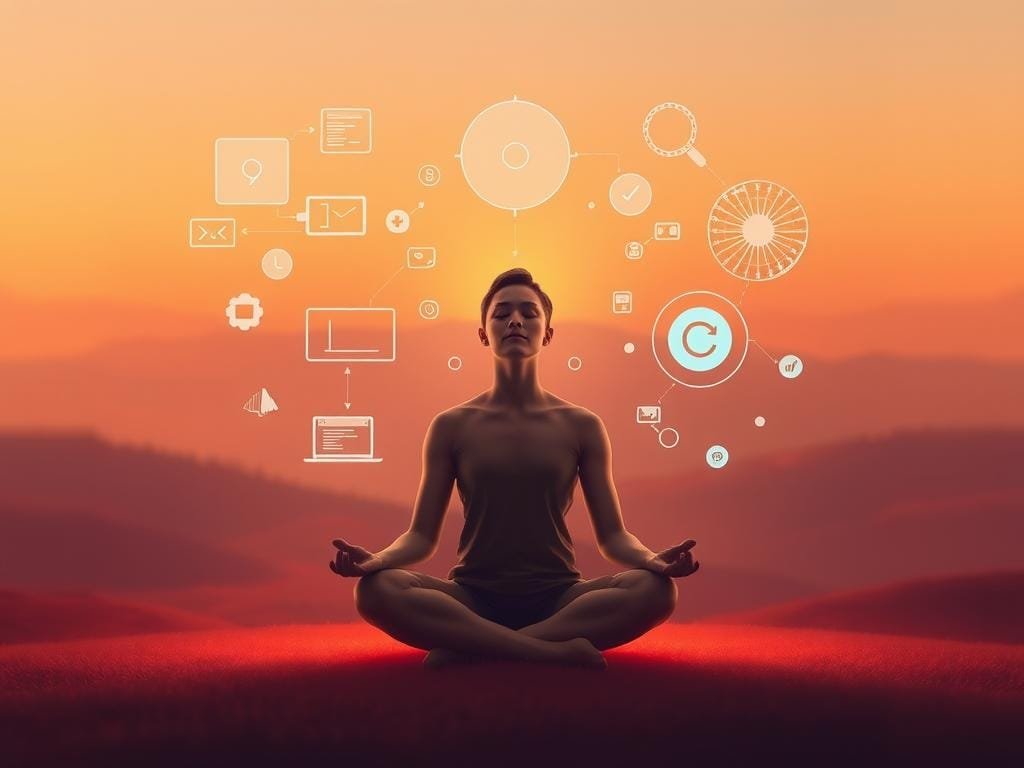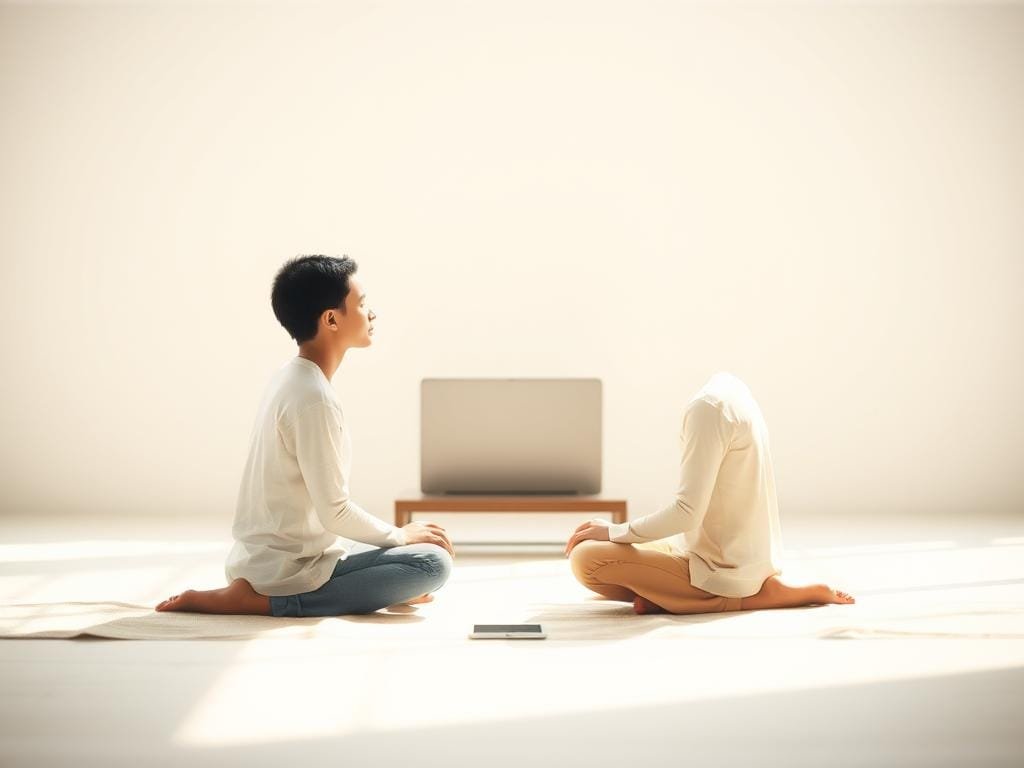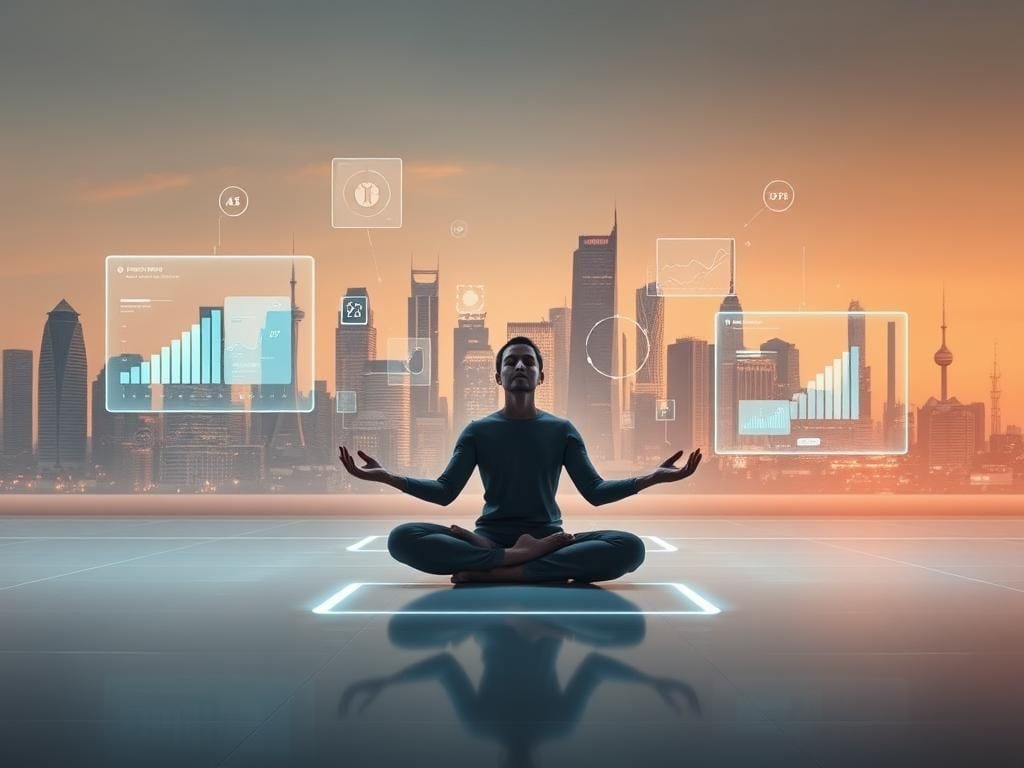Today, technology changes fast, making it hard to keep inner peace. Notifications, screens, and the need to stay current can feel too much. It’s key to find mindfulness in this digital world to keep our minds healthy.
Adding simple mindfulness habits to your day can help. For example, just 5 minutes a day can make a big difference. You can try focusing on your breath or doing a body scan, as we talked about in our article on mindfulness in practice.
Table of Contents
Key Takeaways
- Reduce stress and anxiety with mindfulness practices
- Improve digital well-being by setting boundaries with technology
- Enhance cognitive functioning with regular mindfulness practice
- Integrate mindfulness into daily routines through habit stacking
- Utilize mindfulness apps like Headspace and Calm for guided meditations
Understanding the Digital Age Paradox
We’re caught in the middle of the digital age’s benefits and drawbacks. Technology has changed how we work, talk, and see the world. Our devices are now a big part of our daily lives.
Information and staying in touch with others are both good and bad. Technology lets us find info and keep in touch easily. But it also makes us always connected, which can harm our mental health.
The Constant Connection Conundrum
Being always connected to our devices can hurt our mental health. It can cause too much info, stress, and feeling overwhelmed.
“The problem is not the technology itself, but how we manage it.” –
To solve this, we need to set limits. For example, having device-free times or places can help.
How Technology Affects Your Mental Landscape
Technology affects our minds in many ways. It gives us access to mental health tools and mindfulness apps. But too much tech use can make anxiety and depression worse.
| Aspect | Positive Impact | Negative Impact |
|---|---|---|
| Social Connection | Enhanced connectivity with others | Increased feelings of loneliness |
| Information Access | Vast resources available | Information overload |
| Mental Health Resources | Access to mindfulness and therapy apps | Potential for dependency on digital solutions |
It’s key to know how tech affects our minds. This way, we can use it wisely and keep our mental health good.
By being smart about our tech use, we can deal with the digital age’s challenges. We need to be aware of tech’s effects on our minds. And take steps to keep a healthy balance between digital and real life.
The Science Behind Mindfulness Digital Age Practices
In today’s digital world, knowing the science of mindfulness is key. Mindfulness means being fully present and aware of our thoughts and feelings without judgment. It’s rooted in ancient practices.
Mindfulness has become popular for its benefits against technology’s negative effects on our minds. It can help us feel less stressed, stay focused better, and improve our overall well-being.
Neurological Benefits of Mindful Tech Use
Studies show that using technology mindfully can boost our brains in many ways. These include:
- Reduced stress: Mindfulness lowers stress hormones like cortisol, making us calmer.
- Improved focus: It helps us stay present and focused, reducing distractions.
- Enhanced cognitive flexibility: Mindfulness makes us better at adapting to digital changes.
Dr. Dan Siegel, a UCLA professor, says, “Mindfulness is essential for our brains to work at their best.”
“The best way to take care of your mind is to take care of your brain, and mindfulness is one of the most effective ways to do that.”
Research-Backed Evidence for Digital Wellness
Many studies have looked into mindfulness and digital wellness. For example, a study in the Journal of Behavioral Addictions found mindfulness helps with internet addiction. Another study at the University of California, Irvine, showed mindfulness improves emotional control with digital distractions.
This research shows mindfulness in our digital lives can lead to:
- Better handling of digital distractions
- Improved emotional control with technology stress
- Greater well-being in the digital age
By understanding mindfulness and its digital wellness benefits, we can use it to improve our tech use.
Recognizing Digital Overwhelm: Warning Signs
In today’s world, it’s key to spot digital overwhelm signs for your well-being. Too many emails, messages, news, and social media can cause stress and mental overload.
Physical Symptoms of Tech Overload
Digital overwhelm shows up in physical ways. You might see:
- Eye strain and headaches from too much screen time.
- Sleep disturbances from blue light from devices.
- Musculoskeletal issues like neck and back pain from bad posture.
These signs can really affect your day and how well you work. Knowing them is the first step to lessening their impact.
Emotional Indicators of Digital Burnout
Digital overwhelm also affects your emotions and mind. Look out for:
- Anxiety and feeling overwhelmed by digital info.
- Decreased attention span and trouble focusing because of digital distractions.
- Feelings of isolation even when you’re always online.
Spotting these emotional signs is vital for managing digital overwhelm and keeping a healthy digital-life balance.
By knowing the signs of digital overwhelm, you can protect your mental and physical health in today’s digital world.
Foundation Practices for Digital Mindfulness
Digital mindfulness starts with simple yet powerful practices. These practices can change how you use technology. By adding these practices to your daily life, you can use technology more mindfully.
Mindful Breathing Techniques for Screen Time
Mindful breathing helps reduce stress and focus during screen time. Start by taking a few deep breaths before using your device. Then, breathe naturally, focusing on how your breath feels.
- Take slow, deep breaths in through your nose and out through your mouth.
- Focus on the sensation of your breath filling your lungs.
- When your mind wanders, gently bring your attention back to your breath.
Grounding Exercises Between Digital Sessions
Grounding exercises help you switch between digital tasks and feel less overwhelmed. Try these simple exercises every day:
- Take a few moments to notice the sensation of your feet on the ground.
- Pay attention to the sounds around you, noticing the different frequencies and volumes.
- Notice the sensation of the air on your skin, feeling its temperature and texture.
Cultivating Present-Moment Awareness While Using Devices
Being present while using devices takes intention and practice. Start by noticing your thoughts, feelings, and physical sensations as you use your device.
Tips for cultivating present-moment awareness:
- Notice when you’re mindlessly scrolling or clicking.
- Pause and take a few deep breaths when you feel yourself getting caught up in a digital task.
- Use your senses to ground yourself in the present moment, noticing the sights, sounds, and sensations around you.

By using these foundation practices, you can use technology more mindfully. This leads to a healthier balance between your online and offline life.
Creating Mindful Tech Habits in Your Daily Routine
In today’s world, it’s key to have mindful tech habits for peace. Using technology mindfully can make your digital life better.
Morning Rituals Before Device Engagement
Starting your day with mindful rituals is great. Try mindful breathing exercises or a short meditation before your devices. It brings calm and focus for the day.
For more on Gen Z’s digital peace, check this article. It talks about mindfulness in the digital world.
Mindful Transitions Between Digital Tasks
Switching tasks mindfully can cut down on digital stress. Take a few deep breaths or go for a short walk between tasks. This makes you more focused and less stressed.
Evening Wind-Down Practices for Better Sleep
Good sleep starts with evening wind-down practices. Stay off screens for at least an hour before bed. Instead, read or listen to calming music. A bedtime routine tells your brain it’s time to sleep, improving your rest.
| Practice | Benefit |
|---|---|
| Morning Rituals | Sets a positive tone for the day |
| Mindful Transitions | Reduces digital overwhelm and improves productivity |
| Evening Wind-Down | Enhances sleep quality |
Mindful Communication in Digital Spaces
As we use digital tools, it’s key to be mindful. This helps our online presence and mental health. Being aware of our online actions makes for a better digital world.

Conscious Social Media Engagement
Social media can make us feel bad about ourselves. It can lead to anxiety and FOMO. Here’s how to use it better:
- Choose what you share and read carefully.
- Leave accounts that make you feel bad.
- Use social media for a reason, not just to scroll.
- Take breaks from it to avoid info overload.
Being mindful on social media can make it better for our mental health.
Mindful Email and Messaging Practices
Email and messaging can be stressful if not managed right. Here are some tips:
- Check emails and messages at set times, not all the time.
- Write clearly and to the point in your messages.
- Use phone calls or video chats for tough topics.
- Try an email-free day or weekend to relax.
These tips can make your digital chats more efficient and less stressful.
Navigating Virtual Meetings with Presence
Virtual meetings are now common with remote work. Here’s how to be present in them:
- Get ready by reviewing the agenda and materials.
- Turn off distractions and find a quiet spot.
- Participate by sharing your thoughts and listening well.
- Use video to improve communication and connections.
Being present in virtual meetings boosts productivity and professional relationships.
Digital Detox Strategies That Actually Work
In today’s digital world, finding ways to disconnect is key. Technology is everywhere, affecting our minds and bodies. It’s vital to take breaks and recharge.
Structured Tech Breaks Throughout Your Day
Setting aside time to not use tech can really help. It lets your mind rest and feel less connected. Try going for a walk or doing deep breathing during these breaks.
- Take a 10-minute break every hour to stretch or meditate.
- Use apps that remind you to take breaks from your screen.
- Schedule tech-free times during meals or during your commute.
Weekend Detox Plans for Mental Clarity
A weekend detox can refresh you for the week ahead. Plan activities that don’t involve tech. This could be outdoor fun, reading, or time with loved ones.
Think about having a digital-free day. Avoid all digital devices. This helps you connect with nature and yourself, leading to clearer thoughts and calm.
Creating Tech-Free Zones in Your Home
Make some areas or times in your home tech-free. This can improve your sleep or make meals more meaningful. For example, make your bedroom or dining area tech-free.
“The key to a successful digital detox is not to completely eliminate technology, but to find a balance that works for you.”
By using these strategies, you can use technology more mindfully. This leads to better mental health and overall well-being.
Leveraging Technology for Mindfulness Digital Age Practices
Technology can help us in the digital age to practice mindfulness. It offers tools and resources to improve our well-being.
Top Meditation Apps for Beginners and Advanced Practitioners
Meditation apps are popular for mindfulness. Here are some top ones:
- Headspace: It has personalized meditation sessions and is easy to use.
- Calm: It offers guided meditations, sleep stories, and music to relax.
- Insight Timer: It has a huge library of free meditations and a timer for tracking.
These apps help both new and experienced meditators. They offer many features for your mindfulness journey.
Digital Tools for Tracking Mindfulness Progress
Tracking your mindfulness progress can keep you motivated. Here are some digital tools:
- Mood fit: It lets you track your mood and see patterns.
- Happify: It has tools and games to manage stress and anxiety.
- Daylio: It helps you track your daily activities and mood for mental well-being insights.
These tools let you see how you’re doing. They help you adjust your mindfulness practices.
Online Communities Supporting Mindful Tech Use
Online communities offer support and connection for mindfulness. Here are some notable ones:
- Reddit’s r/Mindfulness: It’s a place to share mindfulness resources, experiences, and advice.
- Mindful.org: It has articles, guided meditations, and online courses on mindfulness.
- The Mindfulness Exchange: It’s a Facebook community for sharing mindfulness practices and resources.
These communities are great for support and staying motivated in your mindfulness journey.

Mindfulness Practices for Specific Digital Challenges
Living in the digital age means facing unique challenges. It’s important to find ways to deal with these issues mindfully. As technology changes, we need strategies to stay focused in the digital world.
Managing Information Overload Mindfully
Today, we face a lot of information. To handle it, start by choosing what you read or watch. Use the 2-minute rule: deal with it right away if it takes less than 2 minutes.
- Practice focused attention by setting times to check emails or social media.
- Use filters and labels to sort and prioritize your digital messages.
- Try a digital detox for a few hours each day to cut down on info.
| Strategy | Description | Benefit |
|---|---|---|
| Focused Attention | Dedicate specific times to check emails or social media. | Reduces constant switching and mental fatigue. |
| Filters and Labels | Categorize and prioritize digital communications. | Enhances productivity and reduces stress. |
| Digital Detox | Abstain from digital devices for a few hours daily. | Decreases information overload and promotes relaxation. |
Dealing with Digital Distractions
Digital distractions can hurt our productivity and peace of mind. To fight them, be aware of when and why you get distracted.
- Use website blockers or apps to stay on task.
- Take scheduled breaks to relax and recharge.
- Stick to single-tasking to avoid getting sidetracked.
Handling Social Media Comparison and FOMO
Social media can make us feel bad about ourselves and anxious. To deal with this, be kind to yourself and remember that social media shows only the best parts of others’ lives.
- Practice gratitude by focusing on the good in your life.
- Limit your social media use to certain times.
- Do offline activities that make you happy and fulfilled.
By using these mindfulness tips daily, you can handle digital challenges better. This helps you stay calm and focused in today’s fast-paced world.
Integrating Mindfulness into Your Digital Workspace
Creating a mindful digital workspace is key for a healthy work-life balance in today’s remote work world. As you set up your workspace, think about how mindfulness can boost your productivity and lower stress.
Setting Up a Mindful Home Office
Your home office should be a calm and productive space. Start by cleaning up your workspace and organizing your digital tools. A tidy space helps clear your mind, making it easier to focus on your tasks.
- Choose a specific area for your workspace to keep work and personal life separate.
- Use ergonomic furniture to stay comfortable during long work hours.
- Add plants or a view to boost your mood and productivity.
A study in the Journal of Environmental Psychology found that offices with natural elements saw a 15% increase in productivity. This is compared to offices without such elements.
“The way we spend our days is, of course, the way we spend our lives.”
Mindful Approaches to Remote Work Challenges
Remote work has its own challenges, like feeling isolated and distracted. Mindfulness can help overcome these issues.
| Challenge | Mindful Approach |
|---|---|
| Isolation | Regular virtual check-ins with colleagues and friends |
| Distractions | Use apps like Freedom or Stay Focused to stay focused |
| Burnout | Practice mindfulness meditation to reduce stress |
Balancing Productivity and Well-being
It’s important to balance being productive with taking care of your well-being. Mindfulness helps you be more aware of your work habits and their effect on your mental health.
Tips for Balancing Productivity and Well-being:
- Set clear goals for your workday to stay focused.
- Take regular breaks for deep breathing or stretching.
- Have a “shutdown” ritual to mark the end of your workday.

By adding mindfulness to your digital workspace, you can make your work environment more harmonious and productive. This boosts your productivity and improves your overall well-being.
Finding Local and Online Mindfulness Resources
Many resources have come up to help you use technology more mindfully. You can find everything from digital wellness retreats to community workshops and professional support. These options support your journey to mindfulness.
Digital Wellness Retreats Across the United States
Digital wellness retreats let you step away from tech and focus on mindfulness. They’re in many places across the U.S. You can enjoy nature and find inner peace. Some top spots include:
- Meditation retreats in the mountains of Colorado
- Yoga and mindfulness retreats in California
- Nature-based digital detox retreats in the Pacific Northwest
When picking a retreat, think about its focus, location, and length. Many offer meditation, yoga, and workshops on using tech mindfully.
Community Workshops for Mindful Technology Use
Community workshops are a great way to learn about mindful tech use. They’re led by experts and cover topics like:
- Mindful communication in the digital age
- Strategies for managing digital distractions
- Practices for being present while using devices
To find workshops near you, look at local wellness centers, yoga studios, and community colleges. Many also offer online workshops for convenience.
Professional Support for Digital Well-being
For personalized guidance, professional support is available. Mindfulness coaches and therapists offer tailored advice. Look for professionals with experience and a good approach.
You can find professionals through online directories, healthcare referrals, or friends’ suggestions. Many offer online sessions for easy access.
By using these resources, you can grow your mindfulness practice. Whether you go to a retreat, join a workshop, or get professional help, you’re on the right path to better digital well-being.
Conclusion: Cultivating Sustainable Digital Mindfulness
In today’s digital world, it’s key to keep your mind at peace. Being mindful of how you use technology helps a lot. It cuts down stress and makes you feel more relaxed.
Mindfulness, like deep breathing and grounding, keeps you in the moment. These activities help you stay focused, even with all the digital distractions. Adding them to your day can improve your digital health and clear your mind.
To grow in digital mindfulness, start small. Try taking breaks from tech, make some areas tech-free, and talk mindfully. These steps will help you feel better and deal with digital stuff more easily.

